Luna 12
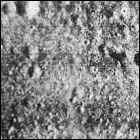 The Soviet Union launches unmanned space probe Luna 12 toward the moon, a near-identical twin of the earlier Luna 11 spacecraft. Luna 12 returns images and observations from lunar orbit for three months until its batteries are exhausted.
The Soviet Union launches unmanned space probe Luna 12 toward the moon, a near-identical twin of the earlier Luna 11 spacecraft. Luna 12 returns images and observations from lunar orbit for three months until its batteries are exhausted.
The Grand Tour
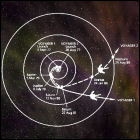 The Grand Tour Outer Planets mission is proposed to NASA by the Jet Propulsion Laboratory. Using a combination of the gravitational assist trajectories computed by JPL’s Michael Minovitch in 1961, Caltech/JPL grad student Gary Flandro has identified a favorable alignment of the outer planets which would allow for a single spacecraft to reach Jupiter, Saturn, Uranus, Neptune and Pluto within two decades. Vehicles taking advantage of this planetary alignment must lift off at very precise times during 1977 and 1978, and the alignment will not occur again for nearly 200 years. An ambitious plan is laid out for multiple flyby vehicles with atmospheric probes for every gas planet and landers for specific moons of interest, launched by Saturn V rockets. Budget realities scale this plan back: flybys will be carried out by two cheaper Mariner vehicles (later renamed Voyager), while the atmospheric and satellite probes – eventually to be renamed Galileo and Cassini – wait even longer to reach their destinations, and the Pluto flyby is scrapped until the 21st century New Horizons probe lifts off. JPL also recommends an inner solar system tryout of the gravitational assist maneuvers required, resulting in the Mariner 10 mission to Venus and Mercury.
The Grand Tour Outer Planets mission is proposed to NASA by the Jet Propulsion Laboratory. Using a combination of the gravitational assist trajectories computed by JPL’s Michael Minovitch in 1961, Caltech/JPL grad student Gary Flandro has identified a favorable alignment of the outer planets which would allow for a single spacecraft to reach Jupiter, Saturn, Uranus, Neptune and Pluto within two decades. Vehicles taking advantage of this planetary alignment must lift off at very precise times during 1977 and 1978, and the alignment will not occur again for nearly 200 years. An ambitious plan is laid out for multiple flyby vehicles with atmospheric probes for every gas planet and landers for specific moons of interest, launched by Saturn V rockets. Budget realities scale this plan back: flybys will be carried out by two cheaper Mariner vehicles (later renamed Voyager), while the atmospheric and satellite probes – eventually to be renamed Galileo and Cassini – wait even longer to reach their destinations, and the Pluto flyby is scrapped until the 21st century New Horizons probe lifts off. JPL also recommends an inner solar system tryout of the gravitational assist maneuvers required, resulting in the Mariner 10 mission to Venus and Mercury.
ESSA-3
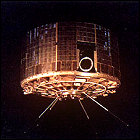 The recently-rechristened Environmental Sciences Service Administration (previously the U.S. Weather Bureau) launches, with the help of NASA, weather satellite ESSA-3, the third in a constellation of Earth-observing weather satellites. The timing of the launch is fortunate, as ESSA-3 takes up its station in orbit mere days before the unexpected shutdown of ESSA-1’s camera system. ESSA-3’s own camera system begins to fail in less than a year, and it is deactivated near the end of 1968 due to continued system failures.
The recently-rechristened Environmental Sciences Service Administration (previously the U.S. Weather Bureau) launches, with the help of NASA, weather satellite ESSA-3, the third in a constellation of Earth-observing weather satellites. The timing of the launch is fortunate, as ESSA-3 takes up its station in orbit mere days before the unexpected shutdown of ESSA-1’s camera system. ESSA-3’s own camera system begins to fail in less than a year, and it is deactivated near the end of 1968 due to continued system failures.
Surveyor 2 doesn’t land on the moon
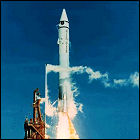 Three days after lifting off from Earth, NASA’s Surveyor 2 robotic probe is en route to the moon when all contact is lost. Thanks to an engine failure, Surveyor 2 is left tumbling out of control, and does eventually reach the moon, slamming into the lunar dust of Copernicus Crater at a leisurely speed of 6,000 miles per hour – perfect for traversing the distance between Earth and moon in a hurry, but not so good for landing intact.
Three days after lifting off from Earth, NASA’s Surveyor 2 robotic probe is en route to the moon when all contact is lost. Thanks to an engine failure, Surveyor 2 is left tumbling out of control, and does eventually reach the moon, slamming into the lunar dust of Copernicus Crater at a leisurely speed of 6,000 miles per hour – perfect for traversing the distance between Earth and moon in a hurry, but not so good for landing intact.
Luna 11
 The Soviet Union launches unmanned space probe Luna 11 toward the moon, the first of a new, smaller generation of Luna probes designed to survey the moon from orbit. Unlike its predecessor, Luna 11 is equipped with cameras, and like NASA’s Lunar Orbiter, Luna 11 is tasked with mapping the moon in advance of a presumed attempt to land cosmonauts there. However, an attitude control problem points Luna 11’s cameras away from the moon, unable to transmit useful imagery back to Earth. Luna 11 remains functional in orbit of the moon for six weeks.
The Soviet Union launches unmanned space probe Luna 11 toward the moon, the first of a new, smaller generation of Luna probes designed to survey the moon from orbit. Unlike its predecessor, Luna 11 is equipped with cameras, and like NASA’s Lunar Orbiter, Luna 11 is tasked with mapping the moon in advance of a presumed attempt to land cosmonauts there. However, an attitude control problem points Luna 11’s cameras away from the moon, unable to transmit useful imagery back to Earth. Luna 11 remains functional in orbit of the moon for six weeks.
Lunar Orbiter 1 launched
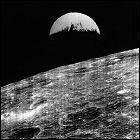 The first of five Lunar Orbiter satellites is launched by NASA, on a mission to map the moon and scout out promising landing sites for the Apollo program. In addition, radiation and micrometeor collision detectors fly aboard each Lunar Orbiter to see if the design specs of the Apollo spacecraft will be adequate to protect astronauts. Lunar Orbiter 1 is the first spacecraft to send home an image of the Earth as seen from the moon. To keep it from being a navigational hazard to future spacecraft, each Lunar Orbiter deorbits and crashes into the moon after completing its survey.
The first of five Lunar Orbiter satellites is launched by NASA, on a mission to map the moon and scout out promising landing sites for the Apollo program. In addition, radiation and micrometeor collision detectors fly aboard each Lunar Orbiter to see if the design specs of the Apollo spacecraft will be adequate to protect astronauts. Lunar Orbiter 1 is the first spacecraft to send home an image of the Earth as seen from the moon. To keep it from being a navigational hazard to future spacecraft, each Lunar Orbiter deorbits and crashes into the moon after completing its survey.
Surveyor 1 lands on the moon
 NASA’s first attempt to soft-land an unmanned space probe on another body in the solar system ends with a perfect landing: Surveyor 1 snaps photos from the moon’s surface, takes measurements of the local environment, and provides valuable engineering data about the surface that will prove helpful in constructing the much heavier Apollo lunar modules that will – it is hoped – take astronauts to the moon by the end of the decade.
NASA’s first attempt to soft-land an unmanned space probe on another body in the solar system ends with a perfect landing: Surveyor 1 snaps photos from the moon’s surface, takes measurements of the local environment, and provides valuable engineering data about the surface that will prove helpful in constructing the much heavier Apollo lunar modules that will – it is hoped – take astronauts to the moon by the end of the decade.
Nimbus 2
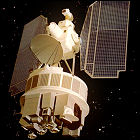 NASA launches the Nimbus 2 satellite, designed to observe weather patterns from orbit and test new weather and climate detection technologies. Nimbus 2’s only means of data storage fails within weeks, and that system’s only backup fails later in the year. Nimbus 2 is shut down in 1969 when the system it uses to maintain orientation to Earth’s horizon also fails.
NASA launches the Nimbus 2 satellite, designed to observe weather patterns from orbit and test new weather and climate detection technologies. Nimbus 2’s only means of data storage fails within weeks, and that system’s only backup fails later in the year. Nimbus 2 is shut down in 1969 when the system it uses to maintain orientation to Earth’s horizon also fails.
Orbiting Astronomical Observatory
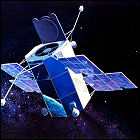 NASA launches its first space-based telescope, the unmanned Orbiting Astronomical Observatory satellite, into Earth orbit. Weighing nearly two tons and sporting visible, ultraviolet, X-ray and gamma ray astronomy capabilities, OAO is in trouble mere minutes after it goes into service: a serious electrical failure leaves the spacecraft in a blind tumble, and it will be declared a loss three days after launch. NASA will attempt another OAO launch in 1968.
NASA launches its first space-based telescope, the unmanned Orbiting Astronomical Observatory satellite, into Earth orbit. Weighing nearly two tons and sporting visible, ultraviolet, X-ray and gamma ray astronomy capabilities, OAO is in trouble mere minutes after it goes into service: a serious electrical failure leaves the spacecraft in a blind tumble, and it will be declared a loss three days after launch. NASA will attempt another OAO launch in 1968.
Luna 10: first to orbit the moon
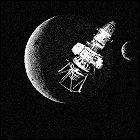 The Soviet Union launches unmanned space probe Luna 10 toward the moon, where it becomes the moon’s first artificial satellite. Luna 10 remains functional for two months, during which a pre-recorded signal from it becomes one of the highlights of the 23rd Congress of the Soviet Communist Party. Luna 10 does not take photos of the moon from orbit, but does find varying concentrations of mass within the lunar surface. This is the last of the original “large” Luna probes, with later orbiters taking on a more compact form, and later large Luna probes containing landers and sample return rockets.
The Soviet Union launches unmanned space probe Luna 10 toward the moon, where it becomes the moon’s first artificial satellite. Luna 10 remains functional for two months, during which a pre-recorded signal from it becomes one of the highlights of the 23rd Congress of the Soviet Communist Party. Luna 10 does not take photos of the moon from orbit, but does find varying concentrations of mass within the lunar surface. This is the last of the original “large” Luna probes, with later orbiters taking on a more compact form, and later large Luna probes containing landers and sample return rockets.
ESSA-2 launched
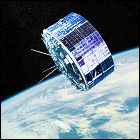 The recently-rechristened Environmental Sciences Service Administration (previously the U.S. Weather Bureau) launches, with the help of NASA, weather satellite ESSA-2, intended to be the second in a constellation of spaceborne observers of Earth’s weather. Virtually identical to ESSA-1, ESSA-2 monitors Earth’s cloud cover for over four years; it is decommissioned in 1970, not because it stops working, but because a newer satellite utilizes the same telemetry frequency.
The recently-rechristened Environmental Sciences Service Administration (previously the U.S. Weather Bureau) launches, with the help of NASA, weather satellite ESSA-2, intended to be the second in a constellation of spaceborne observers of Earth’s weather. Virtually identical to ESSA-1, ESSA-2 monitors Earth’s cloud cover for over four years; it is decommissioned in 1970, not because it stops working, but because a newer satellite utilizes the same telemetry frequency.
ESSA-1: Operational TIROS
 The recently-rechristened Environmental Sciences Service Administration (previously the U.S. Weather Bureau) launches, with the help of NASA, the first “Operational TIROS” weather satellite, ESSA-1. Based on the architecture of the later TIROS satellites, this is intended to be the first fully-operational, long-life weather satellite, in the tradition of many of the long-lived TIROS weather satellites. But eight months into its operational lifetime, ESSA-1’s on board camera system fails, rendering it blind – it becomes useless as a weather satellite and is kept online for engineering experiments until spring 1967.
The recently-rechristened Environmental Sciences Service Administration (previously the U.S. Weather Bureau) launches, with the help of NASA, the first “Operational TIROS” weather satellite, ESSA-1. Based on the architecture of the later TIROS satellites, this is intended to be the first fully-operational, long-life weather satellite, in the tradition of many of the long-lived TIROS weather satellites. But eight months into its operational lifetime, ESSA-1’s on board camera system fails, rendering it blind – it becomes useless as a weather satellite and is kept online for engineering experiments until spring 1967.
Luna 9: first soft landing on another world
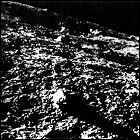 The Soviet Union lands a palpable hit in the space race, claiming the first intact soft-landing of a man-made probe on another body in the solar system. Luna 9, a 200-pound sphere whose weighted base rolls to the correct orientation before opening petals exposing its camera and other instruments, proves that the lunar surface is dense enough to hold up heavy objects (previous scientific speculation has presented the possibility of a heavy lander sinking into a quicksand-like lunar surface).
The Soviet Union lands a palpable hit in the space race, claiming the first intact soft-landing of a man-made probe on another body in the solar system. Luna 9, a 200-pound sphere whose weighted base rolls to the correct orientation before opening petals exposing its camera and other instruments, proves that the lunar surface is dense enough to hold up heavy objects (previous scientific speculation has presented the possibility of a heavy lander sinking into a quicksand-like lunar surface).
Luna 8
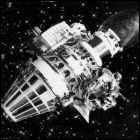 Soviet engineers and space scientists come achingly close to succeeding in landing a robotic lunar lander on the moon’s surface. Luna 8, the latest in a long line of problem-plagued would-be moon explorers, lifts off. A new, improved version of the nearly 3,500-pound spacecraft, Luna 8 manages to last longer than the previous three attempts at Luna landers, but loses control mere minutes from a safe touchdown, crashing into the moon instead. The Soviet Union will finally achieve a safe landing on the moon just two months later with Luna 9.
Soviet engineers and space scientists come achingly close to succeeding in landing a robotic lunar lander on the moon’s surface. Luna 8, the latest in a long line of problem-plagued would-be moon explorers, lifts off. A new, improved version of the nearly 3,500-pound spacecraft, Luna 8 manages to last longer than the previous three attempts at Luna landers, but loses control mere minutes from a safe touchdown, crashing into the moon instead. The Soviet Union will finally achieve a safe landing on the moon just two months later with Luna 9.
Venera 3
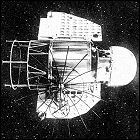 The Soviet Union launches Venera 3, its third attempt to send a spacecraft to Venus. Intended to land on the surface of what is still thought of as a near-twin of Earth, Venera 3’s landing capsule does indeed enter the Venusian atmosphere in March 1966, though the capsule loses contact with Earth and goes silent before ever hitting the surface of Venus. Venera 3 may be the first human-made object ever to arrive on another planet, but no telemetry exists to prove that it arrived in one piece.
The Soviet Union launches Venera 3, its third attempt to send a spacecraft to Venus. Intended to land on the surface of what is still thought of as a near-twin of Earth, Venera 3’s landing capsule does indeed enter the Venusian atmosphere in March 1966, though the capsule loses contact with Earth and goes silent before ever hitting the surface of Venus. Venera 3 may be the first human-made object ever to arrive on another planet, but no telemetry exists to prove that it arrived in one piece.
Venera 2
 The Soviet Venera 2 space probe is launched toward Venus, and for the first time cameras are placed aboard a vehicle bound for that planet. Venera 2 will eventually pass within 14,000 miles of its target, but electrical failures silence the space probe and its instruments long before the flyby.
The Soviet Venera 2 space probe is launched toward Venus, and for the first time cameras are placed aboard a vehicle bound for that planet. Venera 2 will eventually pass within 14,000 miles of its target, but electrical failures silence the space probe and its instruments long before the flyby.
Luna 7
 The Soviet Union launches unmanned space probe Luna 7 to land on the moon, having spent months analyzing the failed flights of Luna 5 and 6 and implementing safeguards against those failures. Unforuntately, however, a different technical problem strikes Luna 7 just hours away from the moon’s surface, preventing it from firing its braking rockets. Luna 7 does reach the moon, but not at a survivable speed, crashing into the surface very close to its intended landing site.
The Soviet Union launches unmanned space probe Luna 7 to land on the moon, having spent months analyzing the failed flights of Luna 5 and 6 and implementing safeguards against those failures. Unforuntately, however, a different technical problem strikes Luna 7 just hours away from the moon’s surface, preventing it from firing its braking rockets. Luna 7 does reach the moon, but not at a survivable speed, crashing into the surface very close to its intended landing site.
Zond 3
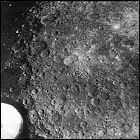 The Soviet Union launches Zond 3, an unmanned spacecraft nearly identical to the failed Mars-bound space probe Zond 2, on a trajectory that will swing past the moon on its way to interplanetary space. It would make its closest flyby to the moon on July 20th, 1965, four years to the day prior to the first manned lunar landing, taking photos of the far side of the moon as it heads into deep space. Zond 3 proceeds on a trajectory toward the orbit of Mars, even though it will be too far away from the planet to study it.
The Soviet Union launches Zond 3, an unmanned spacecraft nearly identical to the failed Mars-bound space probe Zond 2, on a trajectory that will swing past the moon on its way to interplanetary space. It would make its closest flyby to the moon on July 20th, 1965, four years to the day prior to the first manned lunar landing, taking photos of the far side of the moon as it heads into deep space. Zond 3 proceeds on a trajectory toward the orbit of Mars, even though it will be too far away from the planet to study it.
Mariner 4: first pictures from Mars
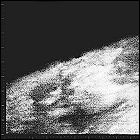 Mariner 4 successfully passes by Mars at a distance of just over 6,000 miles, and transmits the first direct measurements of the Martian environment to Earth, along with the first pictures ever taken of another planet from a nearby spacecraft. Mariner 4’s onboard instruments detect a thin atmosphere – thin enough that any future landing attempts will need to descend on retro rockets, but thick enough that a heat shield is still necessary. These findings have a ripple effect on NASA’s plans for a robotic Mars lander. After its flyby of Mars, Mariner 4 continues on into deep space.
Mariner 4 successfully passes by Mars at a distance of just over 6,000 miles, and transmits the first direct measurements of the Martian environment to Earth, along with the first pictures ever taken of another planet from a nearby spacecraft. Mariner 4’s onboard instruments detect a thin atmosphere – thin enough that any future landing attempts will need to descend on retro rockets, but thick enough that a heat shield is still necessary. These findings have a ripple effect on NASA’s plans for a robotic Mars lander. After its flyby of Mars, Mariner 4 continues on into deep space.
TIROS-10
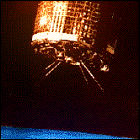 NASA and the United States Weather Bureau launch the tenth and final experimental TIROS weather satellite, TIROS-10. Continuing to test technological upgrades for a fully-functional weather satellite fleet, TIROS-10 also provides additional coverage during hurricane seasons, and remains operational for exactly two years, at which point NASA begins a planned shutdown and phase-out of the experimental TIROS satellites in favor of the Nimbus and ESSA weather satellites.
NASA and the United States Weather Bureau launch the tenth and final experimental TIROS weather satellite, TIROS-10. Continuing to test technological upgrades for a fully-functional weather satellite fleet, TIROS-10 also provides additional coverage during hurricane seasons, and remains operational for exactly two years, at which point NASA begins a planned shutdown and phase-out of the experimental TIROS satellites in favor of the Nimbus and ESSA weather satellites.
Luna 6
 It’s not easy to reach the moon. Just a month after the failed flight of Luna 5, the Soviet Union launches the near-identical unmanned spacecraft Luna 6 to the moon. A pre-programmed mid-course correction engine burn, meant to help Luna 6 coast toward a soft landing on the lunar surface, instead overcorrects. The engine fails to acknowledge a command to stop firing, pushing Luna 6 so far off course that it misses the moon by almost 100,000 miles, dumping the vehicle in an orbit around the sun.
It’s not easy to reach the moon. Just a month after the failed flight of Luna 5, the Soviet Union launches the near-identical unmanned spacecraft Luna 6 to the moon. A pre-programmed mid-course correction engine burn, meant to help Luna 6 coast toward a soft landing on the lunar surface, instead overcorrects. The engine fails to acknowledge a command to stop firing, pushing Luna 6 so far off course that it misses the moon by almost 100,000 miles, dumping the vehicle in an orbit around the sun.
Luna 5: negative, it just impacted on the surface
 Following two years of aborted or otherwise unsuccessful attempts to launch another robotic lunar lander toward the moon, the Soviet Union sends Luna 5 on its way. Intended to be an automated soft-landing mission, Luna 5 encounters major technical problems as it coasts from Earth to the moon. It does eventually reach the moon, but does so out of control and unable to brake for a survivable landing; the plume of material created by the impact of the 3,000-pound Luna 5 is large enough to be spotted from Earth-based telescopes for several minutes.
Following two years of aborted or otherwise unsuccessful attempts to launch another robotic lunar lander toward the moon, the Soviet Union sends Luna 5 on its way. Intended to be an automated soft-landing mission, Luna 5 encounters major technical problems as it coasts from Earth to the moon. It does eventually reach the moon, but does so out of control and unable to brake for a survivable landing; the plume of material created by the impact of the 3,000-pound Luna 5 is large enough to be spotted from Earth-based telescopes for several minutes.
Intelsat I: The Early Bird
 Built for COMSAT (Communications Satellite Corporation) by Hughes Aircraft, borrowing heavily from the design of the successful Syncom experimental satellites earlier in the decade, Intelsat I is launched into a geosynchronous orbit over the Atlantic Ocean, providing telephone, TV, and fax communication via satellite between the United States and Europe. Intelsat I, nicknamed “Early Bird”, doesn’t go operational until COMSAT has completed diagnostics and engineering tests; its first operational use is in June 1965. It will provide satellite transmission of the first live TV coverage of a returning space mission (the splashdown of Gemini 6 in December 1965), and it will be an integral part of the international satellite links necessary for the Our World broadcast in 1967. Despite being retired from regular use in January 1969, it will be reactivated in June 1969 to handle some of the television coverage of the first lunar landing.
Built for COMSAT (Communications Satellite Corporation) by Hughes Aircraft, borrowing heavily from the design of the successful Syncom experimental satellites earlier in the decade, Intelsat I is launched into a geosynchronous orbit over the Atlantic Ocean, providing telephone, TV, and fax communication via satellite between the United States and Europe. Intelsat I, nicknamed “Early Bird”, doesn’t go operational until COMSAT has completed diagnostics and engineering tests; its first operational use is in June 1965. It will provide satellite transmission of the first live TV coverage of a returning space mission (the splashdown of Gemini 6 in December 1965), and it will be an integral part of the international satellite links necessary for the Our World broadcast in 1967. Despite being retired from regular use in January 1969, it will be reactivated in June 1969 to handle some of the television coverage of the first lunar landing.
Ranger 9
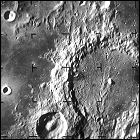 NASA launches the Ranger 9 lunar probe, built by Jet Propulsion Laboratory and intended to go directly to the moon, transmitting pictures of the surface back to Earth until it impacts the lunar surface. Despite NASA scientists’ insistence that the last Ranger probe carry scientific instruments and not just cameras, Ranger 9 is outfitted with cameras only; as a tradeoff, scientists get to nominate its target on the surface, selecting the crater Alphonsus, suspected to be a site of lunar volcanism. Ranger 8 functions flawlessly, sending live video back to Earth until impacting in the crater floor, and for the first time the terminal descent of one of the Ranger probes is broadcast live on TV. This concludes the Ranger program, as NASA now needs to switch its efforts to the unmanned Surveyor lunar landers to find out if the moon’s surface can support the weight of a manned lander. The basic architecture of the Ranger spacecraft is adopted as the heart of the ongoing Mariner planetary space probe series, up to and including the Mariner Jupiter/Saturn ’77 missions (later renamed Voyager) over a decade later.
NASA launches the Ranger 9 lunar probe, built by Jet Propulsion Laboratory and intended to go directly to the moon, transmitting pictures of the surface back to Earth until it impacts the lunar surface. Despite NASA scientists’ insistence that the last Ranger probe carry scientific instruments and not just cameras, Ranger 9 is outfitted with cameras only; as a tradeoff, scientists get to nominate its target on the surface, selecting the crater Alphonsus, suspected to be a site of lunar volcanism. Ranger 8 functions flawlessly, sending live video back to Earth until impacting in the crater floor, and for the first time the terminal descent of one of the Ranger probes is broadcast live on TV. This concludes the Ranger program, as NASA now needs to switch its efforts to the unmanned Surveyor lunar landers to find out if the moon’s surface can support the weight of a manned lander. The basic architecture of the Ranger spacecraft is adopted as the heart of the ongoing Mariner planetary space probe series, up to and including the Mariner Jupiter/Saturn ’77 missions (later renamed Voyager) over a decade later.
Ranger 8
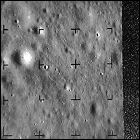 NASA launches the Ranger 8 lunar probe, built by Jet Propulsion Laboratory and intended to go directly to the moon, transmitting pictures of the surface back to Earth until it impacts the lunar surface. Ranger 8 functions flawlessly, sending pictures back to Earth until it slams into the Sea of Tranquility at high speed. Over 7,000 photos are returned, with the last complete picture transmitted prior to impact showing lunar surface features as small as five feet across.
NASA launches the Ranger 8 lunar probe, built by Jet Propulsion Laboratory and intended to go directly to the moon, transmitting pictures of the surface back to Earth until it impacts the lunar surface. Ranger 8 functions flawlessly, sending pictures back to Earth until it slams into the Sea of Tranquility at high speed. Over 7,000 photos are returned, with the last complete picture transmitted prior to impact showing lunar surface features as small as five feet across.
TIROS-9
 NASA and the United States Weather Bureau launch the ninth experimental TIROS weather satellite, TIROS-9. Heavier than any of the other TIROS experimental satellites, and with cameras mounted on opposite sides of the satellite’s cylindrical body to keep the Earth in view at all times. The result, in February, is the first-ever snapshot of the entire world’s weather patterns within a single day. TIROS-9 also carries other upgrades being considered for an upcoming fleet of full-time operational weather satellites, and remains in service for three and a half years.
NASA and the United States Weather Bureau launch the ninth experimental TIROS weather satellite, TIROS-9. Heavier than any of the other TIROS experimental satellites, and with cameras mounted on opposite sides of the satellite’s cylindrical body to keep the Earth in view at all times. The result, in February, is the first-ever snapshot of the entire world’s weather patterns within a single day. TIROS-9 also carries other upgrades being considered for an upcoming fleet of full-time operational weather satellites, and remains in service for three and a half years.
Voyager… to Mars!
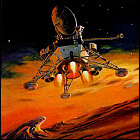 Following up on preliminary studies assuming almost-Earthlike conditions, NASA commences work on a major robotic interplanetary landing mission called Voyager, which will use a Saturn IB rocket to send an orbiter with two landers to Mars. But NASA is doing so without much help from its usual interplanetary think-tank, Jet Propulsion Laboratory, whose scientists warn NASA that the latest astronomical data suggests a significantly thinner atmosphere and lower atmospheric pressure than the scenario for which NASA is designing its vehicles. As the complexity involved in creating self-guided landers with on-board laboratories increases, contractors begin to insist that only a Saturn V will do; since all Saturn V boosters are currently in reserve for Apollo lunar missions, NASA pushes the Voyager mission back into the 1970s.
Following up on preliminary studies assuming almost-Earthlike conditions, NASA commences work on a major robotic interplanetary landing mission called Voyager, which will use a Saturn IB rocket to send an orbiter with two landers to Mars. But NASA is doing so without much help from its usual interplanetary think-tank, Jet Propulsion Laboratory, whose scientists warn NASA that the latest astronomical data suggests a significantly thinner atmosphere and lower atmospheric pressure than the scenario for which NASA is designing its vehicles. As the complexity involved in creating self-guided landers with on-board laboratories increases, contractors begin to insist that only a Saturn V will do; since all Saturn V boosters are currently in reserve for Apollo lunar missions, NASA pushes the Voyager mission back into the 1970s.
Zond 2
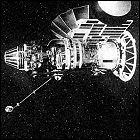 The Soviet Union launches the unmanned space probe Zond 2, intended to conduct the first close flyby of the planet Mars. Interplanetary exploration is still in its infancy, however, and just as Zond 1 failed mere weeks away from Venus, communication is lost with Zond 2 three months prior to its planned August 1965 encounter with the red planet. A backup of this spacecraft, Zond 3, will be launched in 1965, also failing to reach Mars but instead returning photos of Earth’s moon.
The Soviet Union launches the unmanned space probe Zond 2, intended to conduct the first close flyby of the planet Mars. Interplanetary exploration is still in its infancy, however, and just as Zond 1 failed mere weeks away from Venus, communication is lost with Zond 2 three months prior to its planned August 1965 encounter with the red planet. A backup of this spacecraft, Zond 3, will be launched in 1965, also failing to reach Mars but instead returning photos of Earth’s moon.
Mariner 4 to Mars
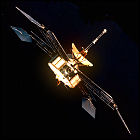 NASA attempts a second unmanned launch to Mars, successfully putting Mariner 4 on course for its nine-month cruise to the red planet. Intended to take the first-ever close-up pictures from the vicinity of another planet, Mariner 4’s main engineering objective is to simply survive the trip. The main problem encountered en route is a flaky star tracker (intended to lock onto specific stars and keep Mariner 4 in the correct orientation).
NASA attempts a second unmanned launch to Mars, successfully putting Mariner 4 on course for its nine-month cruise to the red planet. Intended to take the first-ever close-up pictures from the vicinity of another planet, Mariner 4’s main engineering objective is to simply survive the trip. The main problem encountered en route is a flaky star tracker (intended to lock onto specific stars and keep Mariner 4 in the correct orientation).
Mariner 3 goes nowhere
 Though successfully launched, NASA’s Mariner 3 – one of a pair of identical robotic probes intended to become the first space probes to fly by Mars – fails to properly deploy, stranded in the nose cone of the rocket that took it into space. Unable to spread its solar panels, Mariner 3 simply never activates and is lost in space. The liftoff of its sister ship, Mariner 4, is still a few weeks away, giving engineers time to prevent the same mishap from occurring again.
Though successfully launched, NASA’s Mariner 3 – one of a pair of identical robotic probes intended to become the first space probes to fly by Mars – fails to properly deploy, stranded in the nose cone of the rocket that took it into space. Unable to spread its solar panels, Mariner 3 simply never activates and is lost in space. The liftoff of its sister ship, Mariner 4, is still a few weeks away, giving engineers time to prevent the same mishap from occurring again.